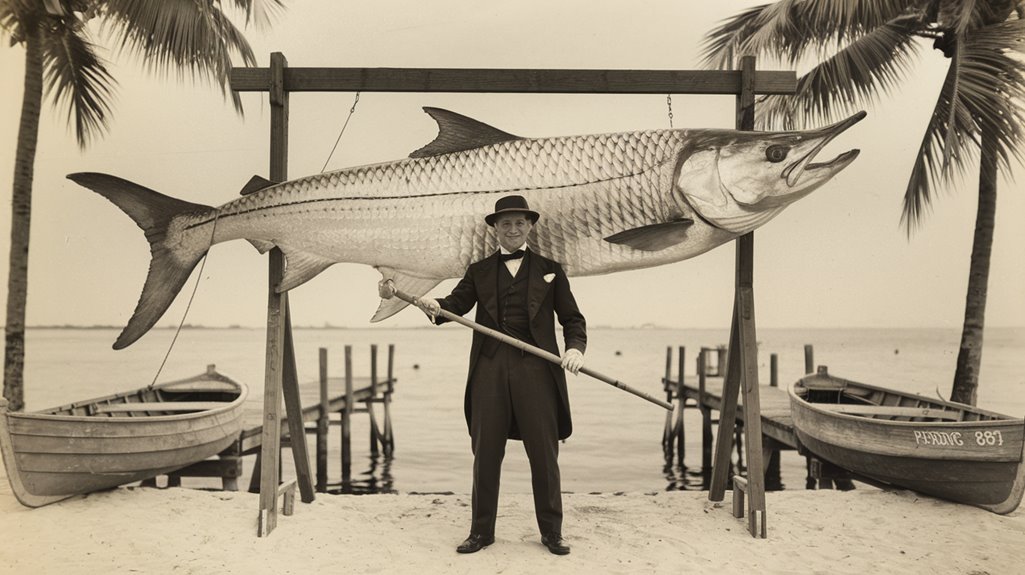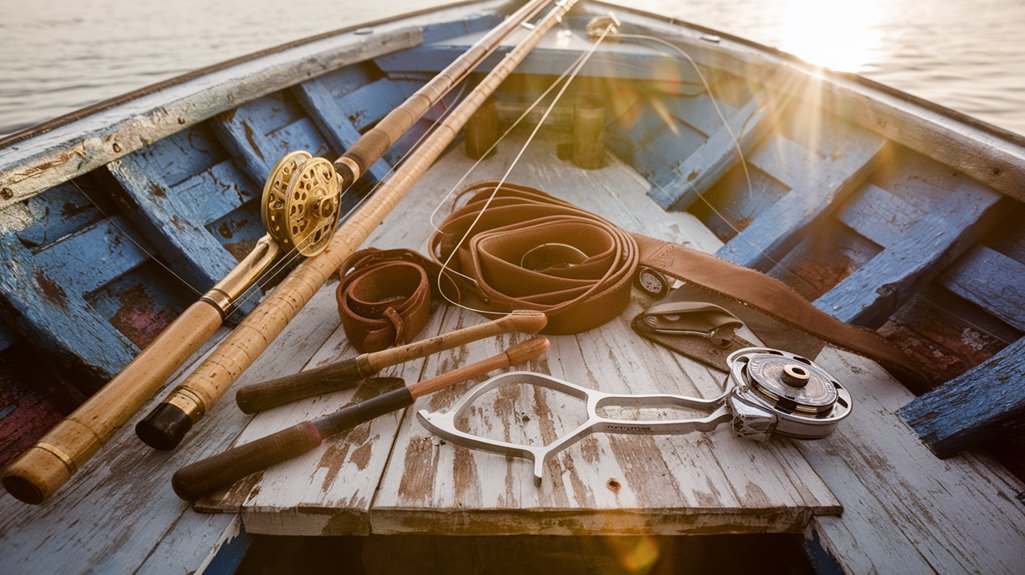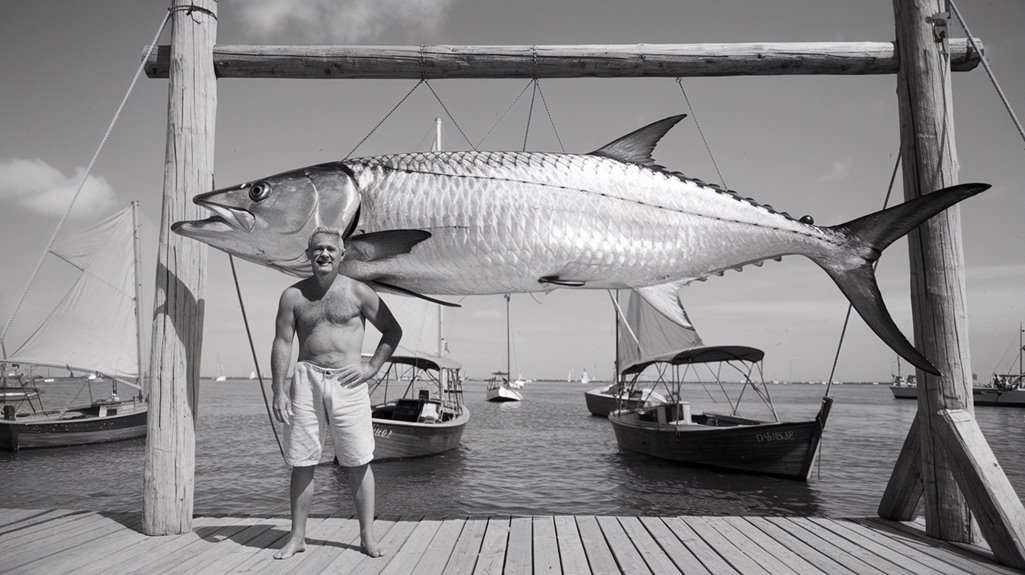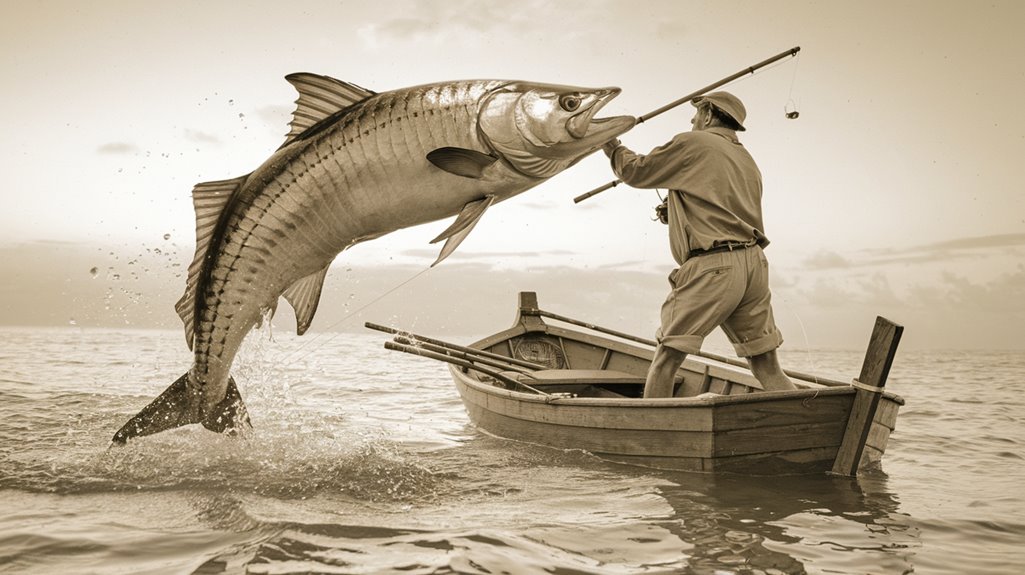You'll find tarpon fishing's origins deeply rooted in the late 19th century, when William Halsey Wood's legendary 93-pound catch sparked a revolution in sport fishing. As wealthy anglers flocked to Florida's Gulf Coast, they brought innovative equipment and techniques that would transform the pursuit forever. From bamboo rods to modern carbon fiber, and from gaff hooks to catch-and-release practices, the evolution of tarpon fishing presents a fascinating journey through America's recreational fishing heritage.
- Key Takeaways
- The Birth of Recreational Tarpon Fishing (1885-1900)
- Early Pioneers and Revolutionary Techniques
- Game-Changing Equipment and Technological Milestones
- Record-Breaking Catches Through the Decades
- Tampa Bay's Rise as a Premier Fishing Destination
- The Golden Age of Tournament Fishing
- Modern Conservation Practices and Sustainability
- Impact on Local Communities and Economics
- Scientific Research and Population Management
- Frequently Asked Questions
- Conclusion
Key Takeaways
- Recreational tarpon fishing began in 1885 with William Wood's 93-pound catch, transforming Florida's southwest coast into an elite sporting destination.
- Edward vom Hofe's star drag reel invention in 1902 revolutionized fishing control, while A.W. Dimmock's weight formula promoted catch-and-release practices.
- World records evolved from Jim Holland Jr.'s 200-pound catch to Max Domecq's 286-pound record in 2003, establishing new benchmarks.
- Modern conservation practices emphasize catch-and-release protocols, circle hooks, and limited harvest tags to protect tarpon populations.
- Scientific research and monitoring technologies now track population movements and spawning patterns, supporting sustainable fishing regulations.
The Birth of Recreational Tarpon Fishing (1885-1900)

While various forms of fishing had existed for centuries, the modern era of recreational tarpon fishing emerged in 1885 when William Halsey Wood landed a 93-pound tarpon in Florida's aptly named Tarpon Bay.
This first tarpon caught on rod and reel sparked a revolution in sport fishing, drawing wealthy enthusiasts from across America and Europe to Florida's pristine waters. By 1894, you'd find the waters teeming with anglers, as evidenced by an impressive 438 documented catches. The history of tarpon fishing transformed Florida's southwest coast into an elite sporting destination, particularly attracting affluent sportsmen from the Northeast. Recreational tarpon fishing quickly evolved from a novel pursuit into a prestigious sporting activity, establishing Florida as the epicenter of what would become one of America's most celebrated big-game fishing traditions.
Early Pioneers and Revolutionary Techniques
After Wood's groundbreaking catch in 1885, a new generation of pioneering anglers emerged to revolutionize tarpon fishing techniques and equipment. In the early 20th century, Edward vom Hofe's star drag reel innovation transformed the sport, giving you unprecedented control when battling these magnificent fish. A.W. Dimmock's contributions to conservation efforts through his 1911 weight formula encouraged catch and release practices, setting new standards for responsible angling.
| Period | Innovation | Impact |
|---|---|---|
| 1885 | Wood's First Catch | Sport Fishing Begins |
| 1902 | Star Drag Reel | Better Fish Control |
| 1911 | Weight Formula | Conservation Focus |
| 1950s | Live Bait Methods | Enhanced Success |
| 1980s | Fly Fishing | Sport Revolution |
These early pioneers' techniques laid the foundation for modern tarpon fishing methods, evolving from basic equipment to sophisticated approaches that you'll recognize in today's sport.
Game-Changing Equipment and Technological Milestones

Throughout the early twentieth century, revolutionary advancements in fishing equipment transformed tarpon angling from a rudimentary pursuit into a sophisticated sport. Edward vom Hofe's introduction of the star drag reel in 1902 marked a turning point, enabling you to better control and land powerful tarpon. This innovation sparked continuous improvements in tackle design and handling techniques.
Record-Breaking Catches Through the Decades
Since the dawn of competitive tarpon fishing, anglers have pursued increasingly impressive catches, leading to a series of remarkable world records. You'll find that 2001 marked a pivotal moment when Jim Holland Jr. landed the first 200-plus-pound tarpon on fly tackle. By 2003, Max Domecq shattered expectations with his 286-pound, 9-ounce catch in Guinea-Bissau, while Tom Evans Jr. claimed the fly-fishing record with a 190-pound, 9-ounce specimen.
Key milestones in tarpon angling history:
- Sierra Leone's emergence as a premier fishing destination, holding nine world records
- Josh Jorgensen's 2021 estimated 312-pound catch in Colombia, setting new possibilities
- The shift from Billy Pate's long-standing record to Evans' achievement, revolutionizing fly fishing standards
These record-breaking catches continue to shape the sport's evolution and highlight emerging global hotspots.
Tampa Bay's Rise as a Premier Fishing Destination

Tampa Bay's emergence as a premier tarpon fishing destination began in the early 20th century, when you'd find pioneering fishing guides establishing the first dedicated charter operations and docking facilities along the expansive estuary system. You'll notice how the region's natural infrastructure of deep channels and shallow flats created perfect conditions for both resident and migratory tarpon populations, leading to the development of specialized fishing techniques unique to Tampa Bay. The establishment of Boca Grande Pass as the "Tarpon Capital of the World" marked a turning point that's influenced modern conservation efforts, including catch-and-release practices and habitat protection measures that continue to sustain the area's renowned tarpon fishery.
Early Fishing Infrastructure Development
- Establishment of specialized fishing businesses and support services along the coastline
- Formation of influential fishing clubs, particularly the Izaak Walton Club, which fostered community engagement
- Development of tournament facilities and deep-water access points that accommodated both recreational and competitive fishing activities
This infrastructure boom transformed Tampa Bay's waterfront, creating a robust foundation for the region's fishing industry that continues to thrive today.
Modern Conservation Impact Today
Building upon the established infrastructure of Tampa Bay's early fishing industry, modern conservation efforts have transformed the region into a world-renowned tarpon fishing destination. You'll find that sustainable fishing practices, including catch-and-release regulations and gear restrictions, now protect the area's precious tarpon populations.
Organizations like Bonefish & Tarpon Trust have revolutionized tarpon fishing in Florida through their dedication to habitat preservation and angler education. Their work, combined with technological advancements in fishing equipment, has created a balance between successful fishing experiences and ecological responsibility. The results are evident in Boca Grande Pass, which has earned its title as the "Tarpon Capital of the World." Today's anglers benefit from these conservation efforts through increased catch rates, while local communities thrive on the sustainable tourism industry that's developed around this magnificent sportfish.
The Golden Age of Tournament Fishing
As the dawn of the twentieth century emerged, tarpon tournament fishing entered its golden age, with Boca Grande Pass leading the charge as North America's premier competitive fishing destination. Along Florida's west coast, you'd find anglers pursuing the Silver King in organized competitions that transformed local economies and fishing practices.
The Izaak Walton Club on Useppa Island pioneered structured Florida tarpon tournaments, establishing these key developments:
- Implementation of scale collection systems for record verification
- Development of standardized tournament rules and ethical guidelines
- Creation of economic opportunities for coastal communities through seasonal fishing events
Tampa Bay's tournament scene flourished during this period, attracting international competitors and establishing Florida's reputation as the world's leading tarpon fishing destination. These competitions didn't just showcase angling skills—they fundamentally shaped the region's cultural and economic landscape.
Modern Conservation Practices and Sustainability
If you're targeting tarpon today, you'll need to follow strict catch-and-release protocols that emphasize using circle hooks and minimizing the fish's time out of water. Modern conservation methods incorporate sophisticated population tracking systems and weight calculators that let you document your catch without harvesting the fish. These science-based practices, championed by organizations like Bonefish & Tarpon Trust, have revolutionized how anglers interact with these magnificent gamefish while ensuring their survival for future generations.
Catch-and-Release Best Practices
Through the pioneering efforts of conservationists and anglers alike, catch-and-release practices have become fundamental to tarpon fishing's sustainability since the early 20th century. When A.W. Dimmock introduced his weight formula in 1911, you could finally estimate a tarpon's size without harvesting it. Today's Florida tarpon regulations and conservation efforts reflect this legacy of protection.
To guarantee successful catch-and-release outcomes:
- Use circle hooks to minimize internal injuries and increase survival rates
- Follow proper handling techniques as recommended by the Bonefish & Tarpon Trust
- Utilize modern weight calculators to document your catch without keeping the fish
These practices, combined with Florida's strict regulations allowing only one harvest tag annually for tarpon over 40 inches, demonstrate how you're helping preserve these magnificent gamefish for future generations.
Population Monitoring Technology
Modern tarpon conservation extends far beyond catch-and-release practices, incorporating sophisticated tracking technologies that have revolutionized our understanding of these magnificent fish. You'll find organizations like Bonefish & Tarpon Trust utilizing acoustic tags and satellite tracking to monitor population movements and establish effective conservation practices.
Through advanced population monitoring, scientists have discovered that female tarpon can thrive for over five decades, reaching reproductive maturity between 7 and 13 years. This knowledge has led to targeted protection of breeding-age fish through gear restrictions and size limits. Today's sustainable fishing regulations are driven by data collected from these tracking systems, while collaborative research between scientists, local communities, and fishing organizations helps preserve critical tarpon habitats. These combined efforts guarantee the species' survival for future generations while maintaining viable recreational fishing opportunities.
Impact on Local Communities and Economics
When tarpon fishing emerged as a prestigious sport in southwest Florida during the late 1800s, it catalyzed significant economic transformation throughout the region's coastal communities. The influx of wealthy anglers from the Northeast and Europe seeking Florida tarpon created unprecedented opportunities for local economies. You'll find that this period marked a turning point in coastal development, as communities adapted to serve this new market of recreational fishing enthusiasts.
Key economic developments included:
- Establishment of professional guide services and charter operations
- Growth of hospitality businesses catering to visiting anglers
- Creation of fishing tournaments that enhanced regional tourism
Local newspapers played an essential role in promoting the sport, while the emergence of organized fishing activities fostered community pride and eventually led to conservation initiatives that continue to benefit these coastal areas today.
Scientific Research and Population Management
Recent scientific advancements in tarpon research have revolutionized our understanding of these remarkable game fish. You'll find that scientific research has revealed impressive biological characteristics, with females growing up to 300 pounds and living beyond 50 years, while males reach maturity between ages 7 and 13.
Conservation organizations like Bonefish & Tarpon Trust are leading significant studies of spawning patterns and habitat requirements. Their research shows that during the April-July spawning season, a single female can produce up to 12 million eggs. Modern tracking technology now allows you to witness how regulatory measures, such as mandatory catch and release for tarpon over 40 inches, contribute to population management. These conservation efforts combine cutting-edge research with practical fishing restrictions to guarantee sustainable tarpon populations for future generations.
Frequently Asked Questions
What Is the History of the Tarpon Fish?
You'll find tarpon have existed for 100 million years. They're prehistoric fish that gained fame when William Halsey Wood first caught one near Sanibel Island in 1885, launching Florida's sport fishing industry.
How Old Is a 100 Pound Tarpon?
You'll typically find a 100-pound tarpon to be between 10 to 15 years old, as they reach sexual maturity at 7-13 years and can gain 10-15 pounds annually.
Why Is Tarpon Fishing Illegal?
You'll find that tarpon fishing isn't entirely illegal, but it's strictly regulated to protect spawning populations, prevent overfishing, and guarantee sustainable numbers through catch-and-release requirements and limited harvest permits.
Where Is the Tarpon Fishing Capital of the World?
You'll find the Tarpon Capital of the World at Boca Grande Pass, Florida, where deep waters and an extensive estuary system create perfect conditions for these magnificent gamefish year after year.
Conclusion
You've witnessed the remarkable journey of tarpon fishing from Wood's historic 1885 catch to today's sophisticated sport. Through technological advances, tournament evolution, and conservation milestones, tarpon fishing hasn't just transformed recreation – it's shaped coastal economies and marine science. As you consider this legacy, remember that modern anglers aren't just pursuing fish; they're stewarding a tradition that balances sport with sustainability.

